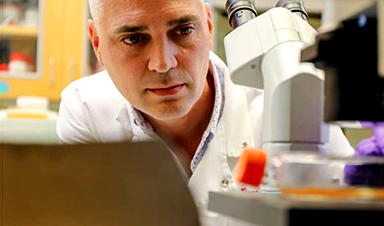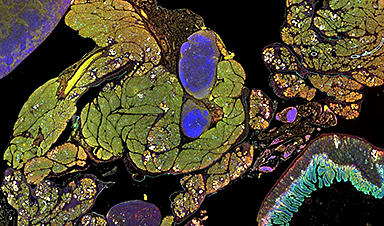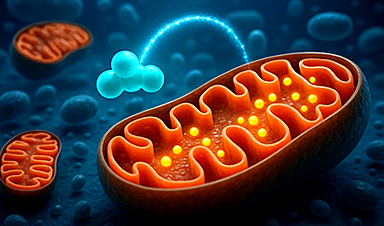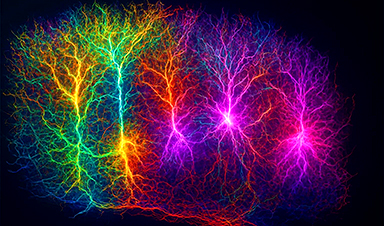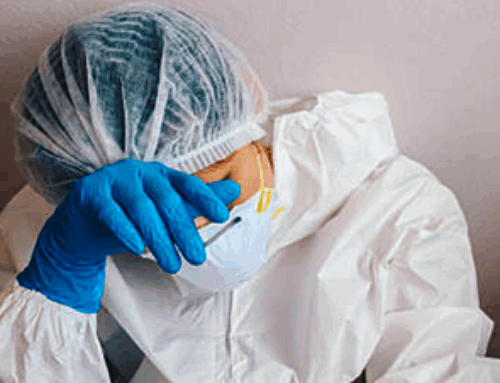New research led by Oregon Health & Science University reveals a promising approach to developing a universal influenza vaccine—a so-called “one and done” vaccine that confers lifetime immunity against an evolving virus.
The study, published today in the journal Nature Communications, tested an OHSU-developed vaccine platform against the virus considered most likely to trigger the next pandemic.
Researchers reported the vaccine generated a robust immune response in nonhuman primates that were exposed to the avian H5N1 influenza virus. But the vaccine wasn’t based on the contemporary H5N1 virus; instead, the primates were inoculated against the influenza virus of 1918 that killed millions of people worldwide.
“It’s exciting because in most cases, this kind of basic science research advances the science very gradually; in 20 years, it might become something,” said senior author Jonah Sacha, Ph.D., professor and chief of the Division of Pathobiology at OHSU’s Oregon National Primate Research Center. “This could actually become a vaccine in five years or less.”
Researchers reported that six of 11 nonhuman primates inoculated against the virus that circulated a century ago—the 1918 flu—survived exposure to one of the deadliest viruses in the world today, H5N1. In contrast, a control group of six unvaccinated primates exposed to the H5N1 virus succumbed to the disease.
Sacha said he believes the platform “absolutely” could be useful against other mutating viruses, including SARS-CoV-2.
“It’s a very viable approach,” he said. “For viruses of pandemic potential, it’s critical to have something like this. We set out to test influenza, but we don’t know what’s going to come next.”
A senior co-author from the University of Pittsburgh concurred.
“Should a deadly virus such as H5N1 infect a human and ignite a pandemic, we need to quickly validate and deploy a new vaccine,” said co-corresponding author Douglas Reed, Ph.D., associate professor of immunology at the University of Pittsburgh Center for Vaccine Research.
This approach harnesses a vaccine platform previously developed by scientists at OHSU to fight HIV and tuberculosis, and in fact is already being used in a clinical trial against HIV.
The method involves inserting small pieces of target pathogens into the common herpes virus cytomegalovirus, or CMV, which infects most people in their lifetimes and typically produces mild or no symptoms. The virus acts as a vector specifically designed to induce an immune response from the body’s own T cells.
This approach differs from common vaccines—including the existing flu vaccines—which are designed to induce an antibody response that targets the most recent evolution of the virus, distinguished by the arrangement of proteins covering the exterior surface.
“The problem with influenza is that it’s not just one virus,” Sacha said. “Like the SARS-CoV-2 virus, it’s always evolving the next variant and we’re always left to chase where the virus was, not where it’s going to be.”
The spike proteins on the virus exterior surface evolve to elude antibodies. In the case of flu, vaccines are updated regularly using a best estimate of the next evolution of the virus. Sometimes it’s accurate, sometimes less so.
In contrast, a specific type of T cell in the lungs, known as effector memory T cell, targets the internal structural proteins of the virus, rather than its continually mutating outer envelope. This internal structure doesn’t change much over time—presenting a stationary target for T cells to search out and destroy any cells infected by an old or newly evolved influenza virus.
Success with a century-old template
To test their T cell theory, researchers designed a CMV-based vaccine using the 1918 influenza virus as a template. Working within a highly secure biosafety level 3 laboratory at the University of Pittsburgh, they exposed the vaccinated nonhuman primates to small particle aerosols containing the avian H5N1 influenza virus—an especially severe virus that is currently circulating among dairy cows in the United States.
Remarkably, six of the 11 vaccinated primates survived the exposure, despite the century-long period of virus evolution.
“It worked because the interior protein of the virus was so well preserved,” Sacha said. “So much so, that even after almost 100 years of evolution, the virus can’t change those critically important parts of itself.”
The study raises the potential for developing a protective vaccine against H5N1 in people.
“Inhalation of aerosolized H5N1 influenza virus causes a cascade of events that can trigger respiratory failure,” said co-senior author Simon Barratt-Boyes, Ph.D., professor of infectious diseases, microbiology and immunology at Pitt. “The immunity induced by the vaccine was sufficient to limit virus infection and lung damage, protecting the monkeys from this very serious infection.”
By synthesizing more up-to-date virus templates, the new study suggests CMV vaccines may be able to generate an effective, long-lasting immune response against a wide suite of new variants.
“I think it means within five to 10 years, a one-and-done shot for influenza is realistic,” Sacha said.
The same CMV platform developed by OHSU researchers has advanced to a clinical trial to protect against HIV, and a recent publication by those scientists suggests it may even be useful for targeting specific cancer cells. The HIV clinical trial is being led by Vir Biotechnology, which licensed the vaccine platform from OHSU.
Sacha sees the development as the latest in the rapid advance of medical research to treat or prevent disease.
“It’s a massive sea change within our lifetimes,” Sacha said. “There is no question we are on the cusp of the next generation of how we address infectious disease.”
In addition to OHSU, research institutions involved in the study included the Tulane National Primate Research Center, the University of Pittsburgh, the University of Washington, and the Washington National Primate Research Center at the UW.
More information: Cytomegalovirus vaccine vector-induced effector memory CD4+ T cells protect cynomolgus macaques from lethal aerosolized heterologous avian influenza, Nature Communications (2024).
News
Studies detail high rates of long COVID among healthcare, dental workers
Researchers have estimated approximately 8% of Americas have ever experienced long COVID, or lasting symptoms, following an acute COVID-19 infection. Now two recent international studies suggest that the percentage is much higher among healthcare workers [...]
Melting Arctic Ice May Unleash Ancient Deadly Diseases, Scientists Warn
Melting Arctic ice increases human and animal interactions, raising the risk of infectious disease spread. Researchers urge early intervention and surveillance. Climate change is opening new pathways for the spread of infectious diseases such [...]
Scientists May Have Found a Secret Weapon To Stop Pancreatic Cancer Before It Starts
Researchers at Cold Spring Harbor Laboratory have found that blocking the FGFR2 and EGFR genes can stop early-stage pancreatic cancer from progressing, offering a promising path toward prevention. Pancreatic cancer is expected to become [...]
Breakthrough Drug Restores Vision: Researchers Successfully Reverse Retinal Damage
Blocking the PROX1 protein allowed KAIST researchers to regenerate damaged retinas and restore vision in mice. Vision is one of the most important human senses, yet more than 300 million people around the world are at [...]
Differentiating cancerous and healthy cells through motion analysis
Researchers from Tokyo Metropolitan University have found that the motion of unlabeled cells can be used to tell whether they are cancerous or healthy. They observed malignant fibrosarcoma [...]
This Tiny Cellular Gate Could Be the Key to Curing Cancer – And Regrowing Hair
After more than five decades of mystery, scientists have finally unveiled the detailed structure and function of a long-theorized molecular machine in our mitochondria — the mitochondrial pyruvate carrier. This microscopic gatekeeper controls how [...]
Unlocking Vision’s Secrets: Researchers Reveal 3D Structure of Key Eye Protein
Researchers have uncovered the 3D structure of RBP3, a key protein in vision, revealing how it transports retinoids and fatty acids and how its dysfunction may lead to retinal diseases. Proteins play a critical [...]
5 Key Facts About Nanoplastics and How They Affect the Human Body
Nanoplastics are typically defined as plastic particles smaller than 1000 nanometers. These particles are increasingly being detected in human tissues: they can bypass biological barriers, accumulate in organs, and may influence health in ways [...]
Measles Is Back: Doctors Warn of Dangerous Surge Across the U.S.
Parents are encouraged to contact their pediatrician if their child has been exposed to measles or is showing symptoms. Pediatric infectious disease experts are emphasizing the critical importance of measles vaccination, as the highly [...]
AI at the Speed of Light: How Silicon Photonics Are Reinventing Hardware
A cutting-edge AI acceleration platform powered by light rather than electricity could revolutionize how AI is trained and deployed. Using photonic integrated circuits made from advanced III-V semiconductors, researchers have developed a system that vastly [...]
A Grain of Brain, 523 Million Synapses, Most Complicated Neuroscience Experiment Ever Attempted
A team of over 150 scientists has achieved what once seemed impossible: a complete wiring and activity map of a tiny section of a mammalian brain. This feat, part of the MICrONS Project, rivals [...]
The Secret “Radar” Bacteria Use To Outsmart Their Enemies
A chemical radar allows bacteria to sense and eliminate predators. Investigating how microorganisms communicate deepens our understanding of the complex ecological interactions that shape our environment is an area of key focus for the [...]
Psychologists explore ethical issues associated with human-AI relationships
It's becoming increasingly commonplace for people to develop intimate, long-term relationships with artificial intelligence (AI) technologies. At their extreme, people have "married" their AI companions in non-legally binding ceremonies, and at least two people [...]
When You Lose Weight, Where Does It Actually Go?
Most health professionals lack a clear understanding of how body fat is lost, often subscribing to misconceptions like fat converting to energy or muscle. The truth is, fat is actually broken down into carbon [...]
How Everyday Plastics Quietly Turn Into DNA-Damaging Nanoparticles
The same unique structure that makes plastic so versatile also makes it susceptible to breaking down into harmful micro- and nanoscale particles. The world is saturated with trillions of microscopic and nanoscopic plastic particles, some smaller [...]
AI Outperforms Physicians in Real-World Urgent Care Decisions, Study Finds
The study, conducted at the virtual urgent care clinic Cedars-Sinai Connect in LA, compared recommendations given in about 500 visits of adult patients with relatively common symptoms – respiratory, urinary, eye, vaginal and dental. [...]
